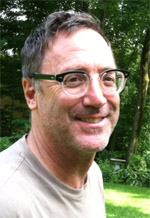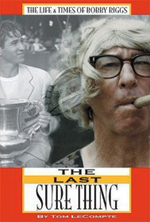Club of Dreams: The Golden Age of
the Los Angeles Tennis Club
Tom LeCompte

Before his death, Jack Kramer, tennis legend and winner of 10 major titles, had just a single trophy on display at his modest Los Angeles home. Not from Wimbledon or Forest Hills or the Davis Cup. It was his club championship trophy.
That might seem odd, given Kramer's achievements and stature. But that trophy was no ordinary trophy from no ordinary tennis club. Winning the Pacific Southwest Championships trophy at the Los Angeles Tennis Club meant you were one of the top five players in the world.
For Kramer, it was also a sentimental choice, for it was at the Los Angeles Tennis Club that he learned to play the game. As a junior, he sparred against adult members including Bill Tilden and Ellsworth Vines, as well as future champions such as Don Budge, Bobby Riggs, Ted Schroeder and Bob Falkenburg.




For more than half a century, the Los Angeles Tennis Club was the epicenter of American tennis, a place that made Southern California synonymous with tennis dominance, a place that nurtured and attracted more tennis champions than any other place in the world. Of the Americans enshrined in the International Tennis Hall of Fame in Newport, R.I., a majority were members of the L.A. Tennis Club.
The list of those who played at the club and went onto greatness reads like a Who's-Who's of tennis: Tilden, Vines, Budge, Riggs, Kramer, Frank Parker, Maureen Connolly, Pancho Segura, Pauline Betz, Pancho Gonzales, Stan Smith, Arthur Ashe, Billie Jean King... and the list goes on. 34 members won major national or international titles.
Many from the Hollywood set, including Clark Gable, Carole Lombard, Charlie Chaplin, Claudette Colbert, Errol Flynn, Gary Cooper, Humphrey Bogart and Howard Hawks attended tournaments there. Many also played at the club themselves.
Baseball may have Yankees Stadium; football, Lambeau Field; golf, Augusta. But no place in perhaps all of sports can claim to have contributed so much to a sport or meant as much to those who played it as the Los Angeles Tennis Club during its golden era.

Set in a pleasant residential area of well-kept bungalows and ranch-style homes not far from the intersection of Hollywood Boulevard and Vine Street, surrounded by an unpretentious stucco wall that shelters the facility's 17 tennis courts, it would be easy to miss if you weren't looking for it.
The low-key Spanish-style clubhouse announces none of the club's rich history. The furnishings are comfortable, but not elegant - testimony to the purposefulness of the place.
As much a living museum as a functioning tennis club, the L.A. Tennis Club since its founding in 1920 has been a mecca for tennis players and fans. In addition to producing a long string of champions, the L.A. Tennis Club was a must-stop as well as a hangout for later generations of players, including Rod Laver and John McEnroe.

Imagine in today's game if on a given day at one tennis club you could find Roger Federer playing a practice match with Novak Djokovic. And on the next court Rafael Nadal practicing with Andy Murray. Plus another 30 or so players with pro titles. And all of them also playing regularly with and learning from legends of previous generations like Pete Sampras, Andre Agassi, and John McEnroe. And playing celebrity doubles with Robert Redford and Meryl Streep.
That was what the LA Tennis Club was like in its day.
"This club over the years has done a lot of service, a lot of good service," said Hall of Famer Gene Mako, who died in 2013 at the age of 97, but loved hanging out and eating lunch at the club for 50 years after his playing days.
Mako started playing at the L.A. Tennis Club as a junior in the late '20s. Though a top-ranked singles player, he went on to be better known as half of one of the greatest doubles teams of all time as partner to Don Budge.

"It's been an outstanding club," Mako told me, recalling how an older member bought him his junior membership when he was 13. "That was a real thrill. He bought it for 25 bucks and paid the $25 dues a year in advance. It was great. It was super great."
To get a junior membership meant the chance to play against and learn from the greats. "I only got to play Tilden about three, four hundred times," joked Mako, going on to say that Tilden, even at 54 years of age, was better than many of today's top players.
A natural progression developed at the club. Older players would play against junior members, helping them develop their technique and learn what it takes to win big matches. The juniors would take that knowledge and go on to make a name for themselves, later returning to the club to mentor the next generation of players. And so it went from Tilden and Vines to Budge and Mako, to Riggs and Parker, to Kramer and Schroeder, to Gonzales.

Jack Kramer told me he picked up much of his hard-hitting, aggressive style from matches he played against Ellsworth Vines, a Los Angeles native who was 10 years his senior and an established champion when he started playing at the club. "Ellsworth Vines would play with me when he was in town and not on the tour. He was a great inspiration," Kramer said.
Then there were the rivalries that developed among the juniors. Kramer recalled this about Bobby Riggs, who was three years his senior, and in 1937 the Number 2 ranked player in the country behind Budge: "He beat me that year, I think, 27 sets in a row. We used to play six or seven sets and then come in and shower. We were the last guys out on the court.

"And I finally asked him one day, 'God dammit, Bobby, why are you so anxious not to let me win a set?' And he says, 'Look, kid, I know you're gonna be a player someday and were gonna meet and I just want you to know who's the boss.'
"That was Bobby. But he was very helpful. He was not only beatin' you, but giving you advice on some things he thought you could do. And he was good about that."
Kramer would get his revenge against Riggs during their celebrated pro tour, which began in Madison Square Garden on Dec. 26, 1947, a day in which the biggest blizzard of the century hit the city. Twenty-seven inches of snow fell, paralyzing transportation, but more than 15,000 people trudged to the Garden to witness the event. Riggs won the initial match, but by the time the head-to-head tour ended more than 60 matches later, Kramer came to dominate the series, forcing Riggs into retirement.

In those days, the pro tours were head-to-head contests between the reigning professional champion and the top amateur challenger. After the tour, to infuse new blood and maintain public interest, the next top amateur player would be enticed to sign on for the next year, with the previous year's losing professional dropping out.
"I really feel that the tennis players in the '30s '40s and '50s, particularly before open tennis came... had a chance to not only meet, play and compete on the tennis court, but they were also friends and pals off the court, something I don't see much today," Kramer said.
"We played cards together, we played golf together, we had dinner together. The guys today are making tons of dough, and that's just great because they deserve it, but I wonder if they have personal, private lives as pleasant as we did."
Junior players today, another American champion Ted Schroeder told me, develop in isolation. Rarely do they get to meet, let alone play against top players, and thus they spend more time hitting balls with their coaches than playing matches.

"We've developed the most wonderful group of ball-strikers I've ever seen. There's only one trouble, none of them knows how to win a close match against top competition. They don't know tactically how to play the game."
Welby Van Horn, a Tennisplayer contributor (Click Here) who died in 2015 and was another product of the L.A. Tennis Club, told me he agreed. Van Horn, who in 1939 got to the finals at Forest Hills before losing to Riggs, moved to Puerto Rico after his playing days and developed one of the most successful junior tennis programs in the country during the 1950s and '60s.
From the comparatively spare facilities of the Caribe Hilton Hotel in San Juan, Van Horn took young children and molded them into top-ranked players, mentoring among others Charlie Pasarell, who in 1967 shared the country's number one ranking with Arthur Ashe. The current tennis academies, Van Horn said, are recruiters rather than teachers.
They go out and find top talent, then offer them inducements for them to train at their facilities. The hard work of nurturing players and honing skills has already been done.
While former greats such as Gene Mako and Jack Kramer were alive they could still be found eating lunch or just visiting old friends at the club. Today the only indications of L.A. Tennis Club's place as the center of the tennis universe are the pictures on the wall, most prominently the club's "Wall of Fame," which greets visitors as they enter the club. These are 34 club members who have won national or international titles.
The photos, all black and white and many blurred, feature many of those players in action. In no particular order there are images of:
May Sutton Bundy
Jack Kramer
Ted Schroeder
Rafael Osuna
Pauline Betz Addie
Ellsworth Vines
Louise Brough Clapp
Alex Olmedo
Jack Tidball
Donald Budge
Bob Falkenburg
Arthur Ashe Jr.
Frank Parker
Pancho Segura
Joseph Hunt
Bob Lutz
Bill Tilden
Darlene Hard
Billie Jean King
Dorothy Bundy Cheney
Lester Stoefen
Alice Marble
Dennis Ralston
Frank Shields
Maureen Connolly
Gene Mako
Budge Patty
Raul Ramirez
Herb Flam
Bobby Riggs
Pancho Gonzales
Stan Smith
It was a very exclusive club.
Next: How the club was built, evolved, and was forever changed by professional tennis.





